Formula One: 1987 San Marino GP
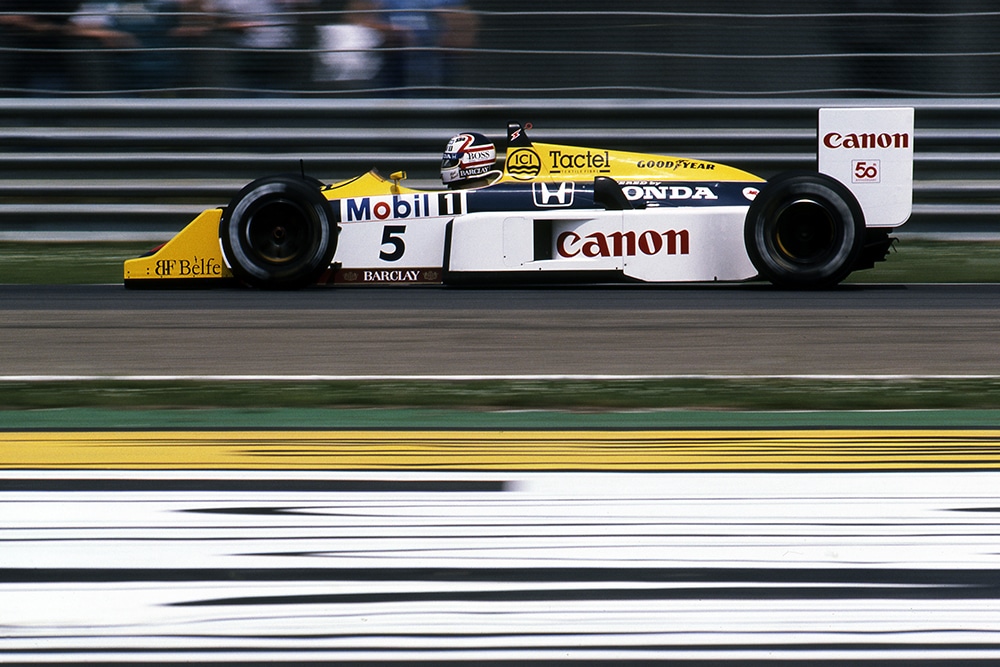
Race winner Nigel Mansell in his Williams FW11B.
© Motorsport Images
Japanese domination
The European part of the Formula One season opened at Imola on May 3, and the well-appointed and interesting Autodromo Dino Ferrari saw Nigel Mansell win almost unchallenged in the absence of his team-mate, and after the World Champion refired.
A full field of 27 entries was ready to go, which meant qualifying was going to have to eliminate one of the hopefuls. As it turned out, however, it was one of the stars that was eliminated, through no fault of his own, so the slowest of the new boys was able to take part.
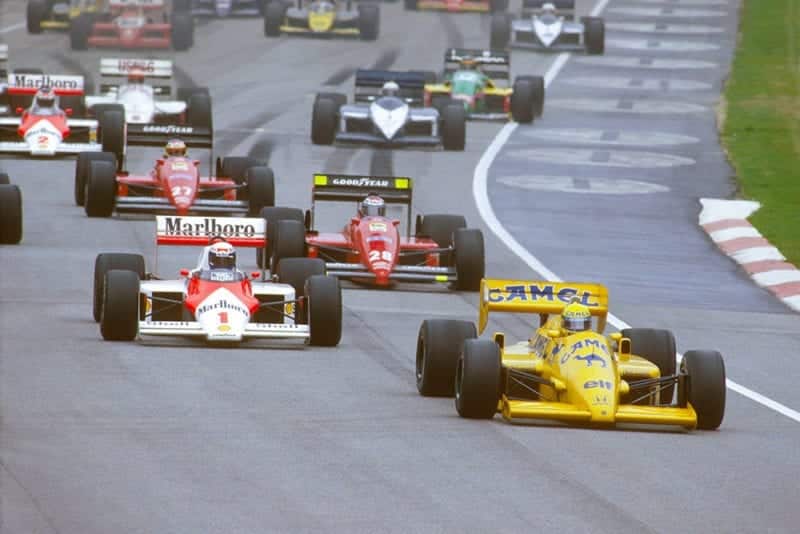
Ayrton Senna (Lotus 99T Honda) leads Alain Prost (McLaren MP4/3 TAG Porsche) and Gerhard Berger (Ferrari 187) at the start.
© Motorsport Images
With Goodyear supplying tyres to everyone this year, and all tyres being to a standard specification for the particular event, the whole tyre situation has had to be something of a compromise, although a front-running Honda-powered car needs different rubber to a back-running Cosworth DFZ-powered one. The Imola circuit is fast, with some highspeed corners and curves, and it was not long before rear tyres were showing signs of distress on the fast cars.
Goodyear does not gamble and keep its fingers crossed, it knows too much about racing-tyre design for that, so it was keeping a close eye on things. Then, during the afternoon qualifying session, Nelson Piquet had a lurid accident on the fast double-left bend after the pits. His Williams-Honda snapped away from him and spun uncontrollably backwards into the barriers, tearing off the left-front suspension, breaking the engine/gearbox assembly away from the monocoque and destroying the left rear suspension. Apart from a hole being punched in the carbon-fibre composite monocoque at the left front corner, the Williams cockpit zone was unscathed, and Piquet got away with a bruised left leg, and a severe brain shaking due to deceleration on impact.
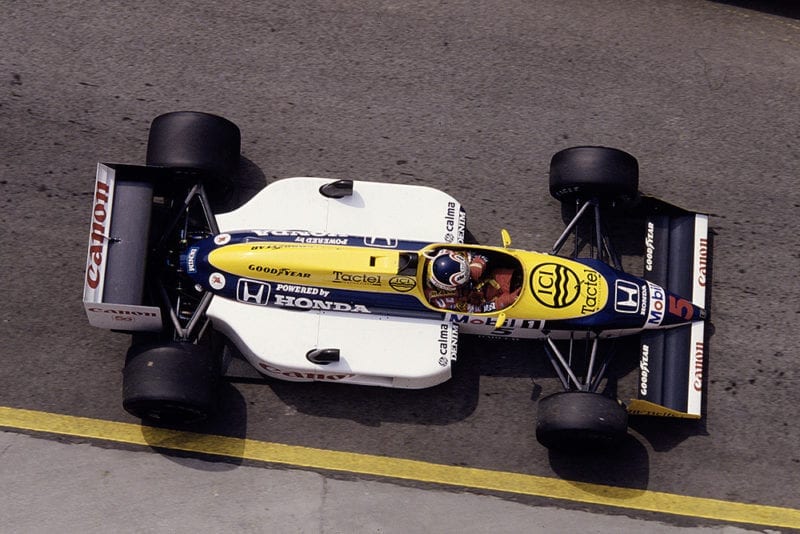
Nigel Mansell driving his Williams FW11B Honda in 1st position.
© Motorsport Images
The car was a write-off and the driver was hospitalised for observation, but naturally everyone wanted to know what had happened. From all accounts there was no question of driver error, no something must have failed, though no-one was prepared to commit themselves as the damage to the car was too extensive to make a simple analysis.
Goodyear, being the responsible firm it is, was prepared to accept that it might have been a tyre failure, but equally, Patrick Head of Williams was prepared to accept that it could hse been a chassis component failure. To remove any possibility of risk, Goodyear withdrew all the rear tyres. By a super-human effort on the part of a lot of people behind the scenes, a supply of different rear tyres was in the paddock next morning, the teams having to accept that they could only have 41/2 sets of rears, instead of the stipulated five sets.
The Williams team had a spare monocoque, so overnight it built it up into a new car, just in case Piquet was going to be allowed to drive. As it turned out, the medical men refused to pass him as 100% fit, and his entry had to be withdrawn. Thus did Gabriele Tarquini in the second Osella manage to get into the race — his first attempt at Formula One.

Stefan Johansson in his McLaren MP4-3, passes the Imola pits on his way to 4th place.
© Motorsport Images
Piquet had made fastest qualifying time up to the point of his accident, and no one improved on it, so he still held pole position when Saturday qualifying beg.. Eventually Mansell improved on the time, and in the dying moments of the Saturday hour Senna beat the Englishman, so the two Honda-powered teams shared the front of the grid. The Honda Motor Company must have been pleased to see such justification for its decision to support two teams in 1987. Porsche was in some trouble on the first day, having problems with three engines in the McLarens, caused by mixture adjustments; but it soon overcame them, and Prost was third fastest overall.
When Johansson’s car had been retrieved on the Friday afternoon, the engine having expired in a cloud of smoke and oil, the plugs were removed and the compressions were checked by cranking it round on the starter motor and inserting a compression tester into each plug hole in turn. All was well until they got to the front cylinder on the left; the gauge did not even flicker. A couple more tries convinced the Porsche people that something awful had happened inside and a long thin torch beam down the plug hole was all that was needed. Nothing was said, but I suspect the engineer could see the crankshalf! Melted pistons usually mean mixture problems.
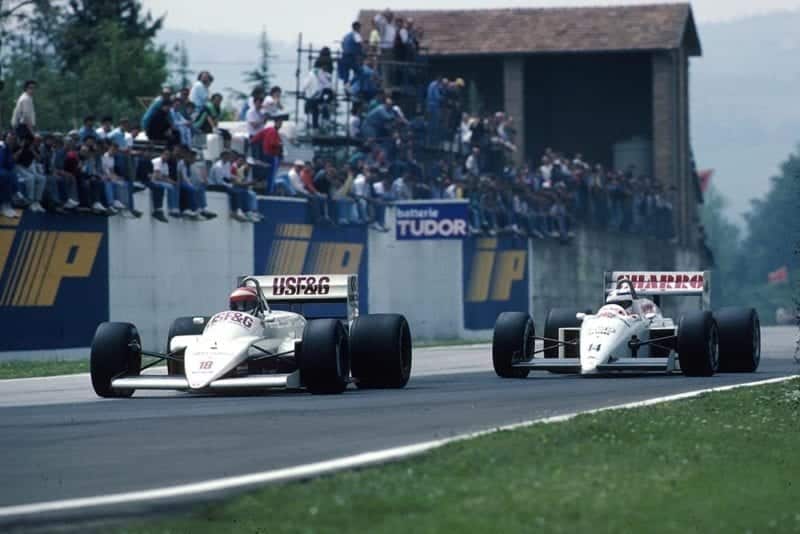
Eddie Cheever (Arrows A10) leads Pascal Fabre(AGS JH22).
© Motorsport Images
The John Barnard-inspired Ferraris, which look like bright red McLarens around the back end (all neat and smooth and efficient, a typical Barnard hall-mark), were encouraging, AIboreto and Berger lining up in the third row of the grid.
The new 90 V6 engine (replacing the long-established 120 unit), and the gearbox in line with the engine and mounted out behind the differential unit (replacing the long established transverse gearbox) were neat and orthodox, and fitted into the Barnard thinking of airflow through and around the rear end of the car.
Having both cars on the third row of the grid would have pleased most teams, but it was not good enough for Ferrari, and especially for the partisan crowd. Ferraris should be on the front row, especially at Imola. The crowd were not impressed.
Last year the Rory Bryne-designed Benetton B186, which came from Toleman roots and was powered by BMW engines, was quite a force to be reckoned with. This year the B187 with the Ford V6 turbo power-unit is right in with the front runners. This poses a lot of questions to which there are an equal number of answers.

Michele Alboreto in his Ferrari F1-87.
© Motorsport Images
Is the Benetton chassis so superior to the Carl Haas Lola of last year? Has Ford come up with a lot more power? Are Fabi and Boutsen that much better than Jones and Tambay were last year? Is the Benetton organisation that much better than the Haas organisation of last year? You can pick your own answers, but the undeniable fact is that this year the Ford powered cars are front-runners, and Ford is smiling.
The FIA/FISA rule makers, in their wisdom, have made a second category to boost the entry lists for 1987. Technical advancement in all aspects of Formula One, thanks to Honda, BMW, Porsche, Ford and top chassis teams such as Williams, McLaren and Lotus, meant the poor relations in the second half of the field were getting left behind, and it looked as though the back end of the grid would die.
The overall plan is to phase out turbocharged engines by 1989 and replace them with naturally-aspirated 31/2-litre engines. So, to encourage the gentle change-over, “Group B” is for cars with 31/2-litre engines without turbocharging or supercharging, and they can weigh 500kg, as against 540kg for turbocharged 11/2 litres.
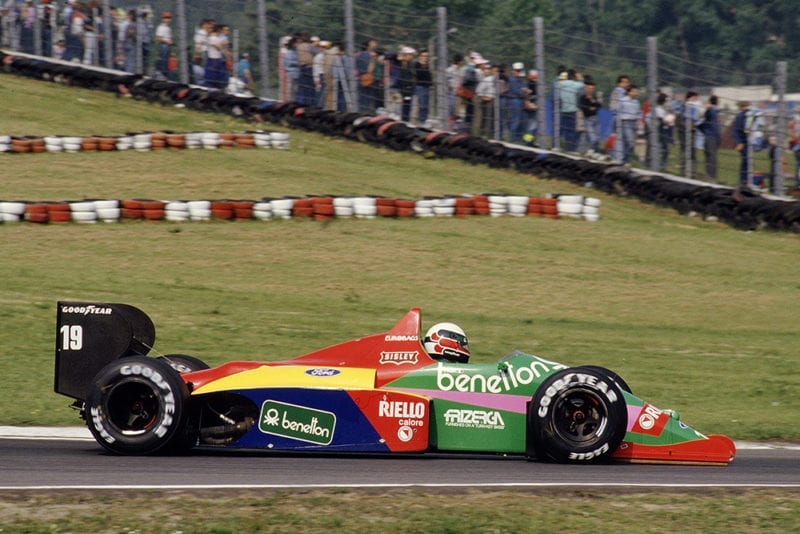
Teo Fabi driving his Benetton B187 Ford.
© Motorsport Images
At the moment “Group B” is a sort of Vintage/Historic category, with low-finance, low-tech, teams using cars from the past, and 31/2-litre versions of the old Cosworth DFV engine. Naturally they incorporate 1987 constructional technology and design futures, but by any standards they can only be regarded as “Vintage”. It is probable that by the end of this season there will be signs of 1988 naturally-aspirated engines appearing from the likes of Honda, Porsche and Ferrari, and then the scene will become more interesting.
The Tyrrell team was quickly away on “Group B”, but is now challenged by a one-car team from Lola, with French backing, and March, with Japanese backing. The French AGS team is unlikely to challenge anyone.
On a non-stop run in the San Marino Grand Prix, the best Tyrrell could manage was only eighth place, two laps behind the winner, and even on a straightforward fast circuit like Imola these cars were embarrassingly in the way at times. This “Vintage” class does not seem like a good idea at the moment.
In spite of qualifying sessions being restricted by the use of standard racing tyres, and a limit of 4 bar on boost-pressures, the Friday and Saturday afternoons are still reality, though not as exciting as they were last year. But when it comes to the race it is a question of compromise on all fronts, particularly as regards fuel consumption, as tankage is still restricted to 195 litres, and no refuelling is allowed.

Rene Arnoux at the wheel of his Ligier JS29B Megatron.
© Motorsport Images
Did those exciting refuelling stops really happen a few years ago? In qualifying Senna made the fastest lap in 1min 25.826, while in the race Fabi made fastest lap in 1min 29.246 and most fast drivers were at 1min 30 or over. In round figures, one can say the race was-run at five seconds a lap slower than was possible, which means the top drivers were racing at the qualifying pace of the Minardis, which doesn’t sound very exciting.
Even then, some midfield runners ran out of petrol before the end of the race, though the high-tech teams have the situation well in hand, with exotic engine-management systems controlling fuel consumption and power, and fuel-flow and contents measuring devices working to accurate limits. Among the unfortunates who ran out of fuel when all seemed well were Derek Warwick and Alex Caffi. The Hampshire driver was particularly annoyed, as a good finish in fifth place would have done him the world of good. The Arrows A10 with its Megatron-financed “upright” BMW engine was going well as “best of the rest”.
The performance of the young Italian driver Alex Caffi was most interesting. He was driving the Osella with turbocharged V8 Alfa Romeo power, which is nearly as old as a Cosworth engine, and reliability has never seemed an intrinsic part of the Osella team. But in the early stages of the race there was this blue Osella running in eleventh position, and there was a tendency to think of it as having been lapped by the leaders.

Gabriele Tarquini in his Osella FA1G Alfa Romeo.
© Motorsport Images
But it hadn’t and was still on the same lap as Mansell; it really was eleventh and going well. The other Osella, driven by Tarquini, was last and that was reality. An unassuming young man is Caffi, happy to be in Formula One, doing his best with what he has got and not moaning about it. His best is certainly impressive. He was a good ninth when he ran out of fuel on lap 55.
Another interesting performance in the race was that of Satoru Nakaiima, the Honda link-man in the Lotus team, driving the number two Lotus. The front-running cars these days have so much electrical “gubbins” on board that the amperage needed to keep everything functioning is pretty high. If your charging system is lacking, or the battery is not up to it, everything will die away, from ignition to instrument panel computer. Nakajima’s car suffered a loss of amps at the start and the car was pushed away while he was inserted into the T-car.
With the start being delayed, the Lotus mechanics were able to fit him into the car, which was set up for Senna, as best they could, and he was able to start from the pit-lane after the field had set off. From last on lap one, he worked his way smoothly up through the field and thanks to numerous retirements was able to finish sixth, thus bringing the third Honda-powered car into the World Championship points-scoring list.
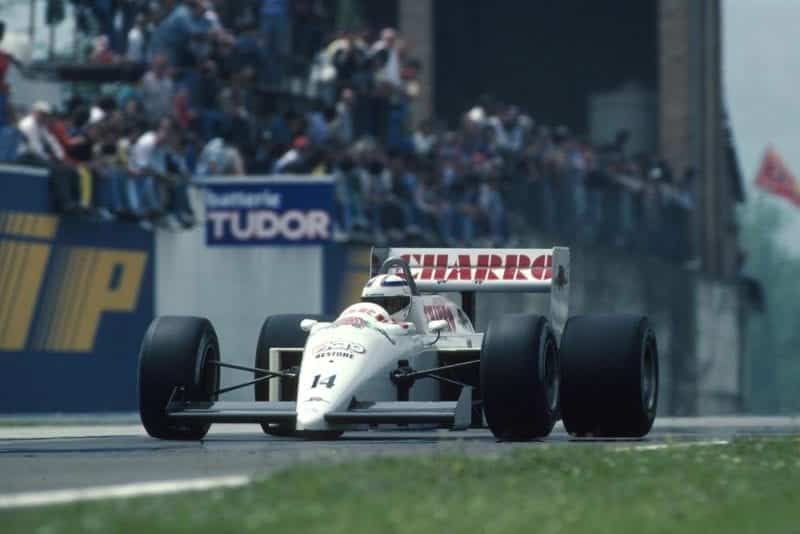
Pascal Fabre driving his AGS JH22.
© Motorsport Images
For television viewers this last-minute change of cars was a great disappointment, for the number two Lotus was fitted with a minature camera mounted on the roll-over structure by the driver’s right ear. It had a good view of the instrument panel, the nose of the car, the right hand front wheel and suspension, and a driver’s-eye view of the track ahead.
It had been tested “live” during the morning warm-up session, and was looking good. At one point someone ran wide onto the grass out of a corner ahead of the Lotus, and the camera showed Nakajima turning his head to the right to see who it was as he passed by. Situated in the middle of the grid, the Lotus at the start and on the opening lap could have provided some very exciting viewing for the armchair spectator, always assuming the television director at the circuit had used it, and Murray Walker had not spoilt the illusion of being in the car with his continuous chatter.
Loss of the all-important amps also put paid to Alain Prost’s race. The drive to the alternator on the Porsche engine failed, the big red light came on, and then everything died away and Prost had to walk back to the pits, his race over. In the closing stages, a similar loss of amperage on Patrese’s Brabham put paid to what was a possible second place. He was luckier than Prost, for most of the systems kept functioning to a degree and the car kept going, albeit at a very reduced rate; but most of those Patrese had been leading all day were able to go by him, and the results gave him ninth, which hardly reflects his performance.
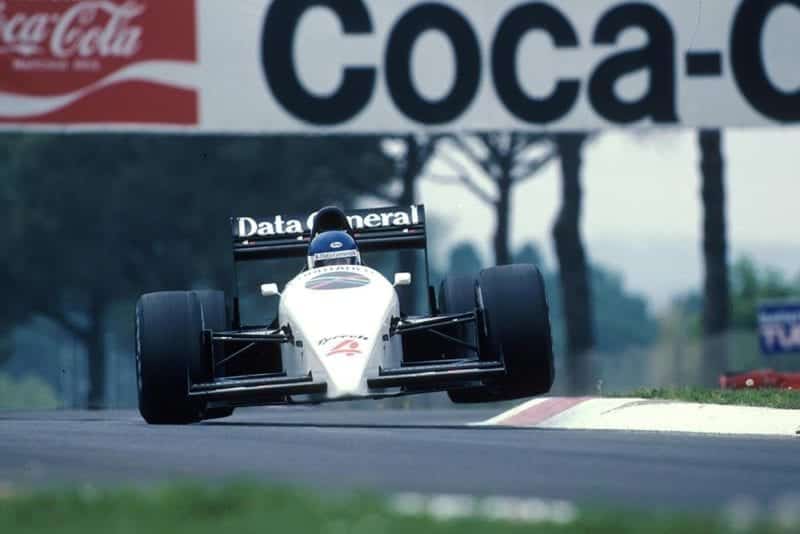
Phillipe Streiff driving his Tyrrell 016.
© Motorsport Images
Telling the television world how it was all happening was a remarkable collection of ex-World Champions, earning an honest crust as commentators. There was one well-known ex-World Champion who did not know the rules about an aborted start.
If the starter is aware of something wrong on the grid he can push the yellow button, which cancels the start so the whole procedure begins again. This can happen either before or after the red light comes on, which normally indicates that the green is due to appear between four and seven seconds later. Obviously the starter has to make a snap decision and act accordingly. With fuel tank capacity limited to 195 litres, the teams need to know exactly how long their engines have to run, so regulations always give the race length, plus one lap for the “parade” from the dummy grid. The Imola race was due to run for 60 laps plus the parade lap. The field had done their parade lap, using a certain quantity of fuel, so now had to have enough left for 60 laps.
As the cars came to rest on the grid proper, Alboreto, Johansson and Brundle all stalled their engines, then Nannini stalled his. The start was aborted with the yellow light, and everyone switched off. A five-minute delay was announced and the race distance reduced to 59 laps, as the cars now had to do another parade lap before coming under starter’s orders again.
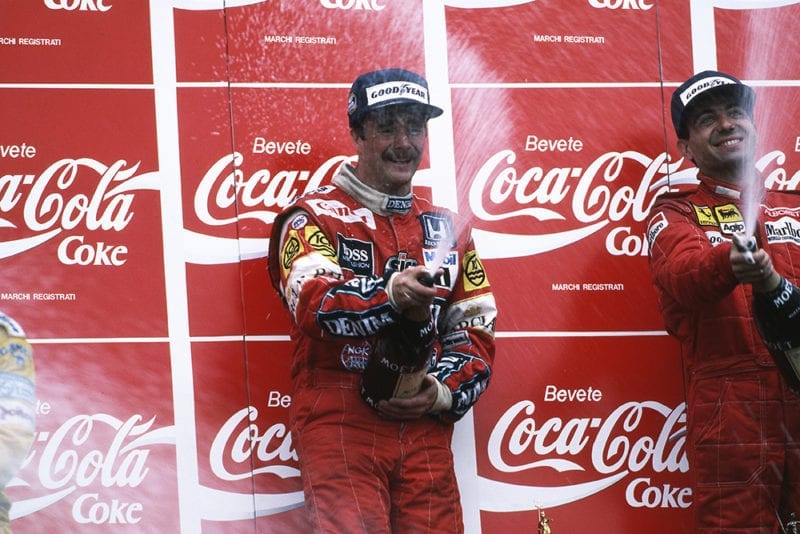
Race winner Nigel Mansell sprays the Champagne with third placed Michele Alboreto.
© Motorsport Images
This time all was well, and the field of 25 cars got away well (with Nakajima joining in from the pit lane). Now, our knowledgeable ex-World Champion seemed to think the race would still be over 60 laps, and that the cars should have had their fuel tanks topped-up before setting off on their second parade lap. In his day that was the procedure, but times have changed.
It was due to this restart that the Olivetti time-keepers had to reprogramme their calculators and computers to work on a 59-lap race instead of a 60-lap race. Stalling your engine on the startline may be frustrating for the driver concerned, but it can cause a lot of panics in many other places.
Everyone keeping a lap chart, either for a team, a journalistic report or out of general interest, had to remember to start at lap 2, or to finish one lap early. And anyone who had made out statistic tables beforehand had to remember to make a correction, while all the pre-race blurb was instantly wrong!
Pity the poor historian. DSJ
